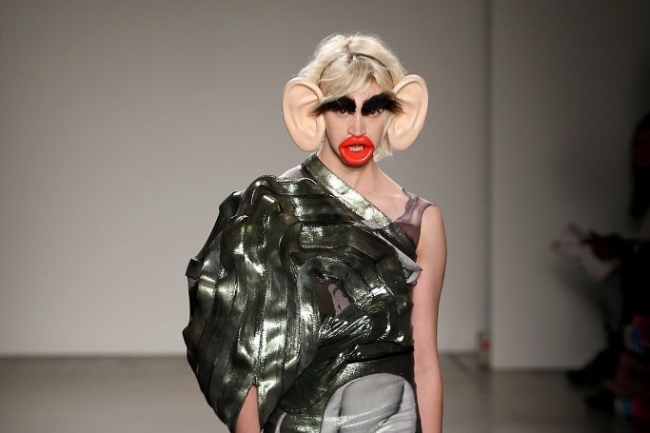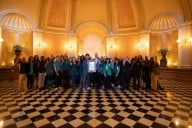You have /5 articles left.
Sign up for a free account or log in.

Bennett Raglin via Getty Images
A controversial and roundly criticized fashion show at the Fashion Institute of Technology is raising larger questions about how much oversight faculty members in fashion design programs should have over students’ work and whether or how students should be directed to consider racial and societal factors in their creative expressions.
The show, which was held on Feb. 7, featured the work of recent graduates of FIT's master's program in fashion design. One of the graduates, Junkai Huang, dressed models in oversize plastic ears and lips and bushy glue-on eyebrows, which many people thought resembled racist caricatures of black people. Amy Lefevre, a black model who was in the show, was the first to call attention to the “clearly racist” accessories she said the director of the show attempted to push her to wear despite her refusal to do so after telling him the accessories made her uncomfortable, according to The New York Times.
Richard Thornn, a London-based creative director hired by FIT to produce the show, told her she would “only be uncomfortable for 45 seconds,” the Times reported.
Lefevre's comments and the pictures of other models wearing the controversial accessories promptly made the rounds on social media, attracting significant media coverage and causing an internal rift at the college.
Much of the criticism for the show was initially directed at Huang, but Joyce Brown, president of FIT, placed the blame squarely on two administrators who, she said in a statement, “failed to recognize or anticipate the racist references and cultural insensitivities that were obvious to almost everybody else.”
Jonathan Kyle Farmer, the chair of the master’s program for fashion design, and Mary Davis, dean of graduate studies, were placed on administrative leave as a result. Brown described their leadership as "inexcusable and irresponsible" and apologized "to those who participated in the show, to students, and to anybody who has been offended by what they saw. Let me be clear: no person should be made to feel uncomfortable -- particularly about race -- in service of their work, job, livelihood, or course of study."
Huang did not select the accessories himself, Brown said in her statement. The Times reported they were recommended by Farmer, who did not respond to requests for comment.
While the imagery implicit in the accessories may have been obvious to many people, So Young Song, a professor of fashion design and merchandising at Illinois State University, wondered if the uproar it caused might stifle student creativity and independence going forward.
“That incident really made me think in terms of students’ activity, like fashion shows, and how we can present this issue but still encourage creative fashion design and fashion show activity from students,” Song said.
Lefevre did not respond to requests for comment. The Black Student Union at FIT issued a statement on Twitter supporting Lefevre and calling the incident “offensive and racist.”
“We request that those who align with our vision, intention and mission -- to explore and celebrate black pride while promoting intellectual, political, social and cultural awareness -- to use their voices to continually support and advocate for justice,” the statement said.
While other models in the show, including another black model, wore the accessories, Lefevre walked the runway without them.
Bethann Hardison, a pioneer and advocate for women of color in the fashion industry, said Lefevre had every right to refuse to wear the offensive accessories. Hardison, who is the founder of the Diversity Coalition, which promotes racial diversity in the fashion industry, saw the accessories as just plain “ugly” rather than a malicious act of racism, but she questioned the motives of those who selected the accessories.
“I don’t blame FIT -- who I blame is any production company and stylist on the job,” she said. “I looked at it like, what are they thinking -- it’s just bad taste. I don’t know what the need was, how the accessory enhanced the garment … What does the designer gain, the controversy? It doesn’t seem to be coming off to his advantage.”
Huang, the designer, claimed ignorance of the insulting symbolism associated with the accessories. He moved from eastern China to New York City in 2017 and is still developing an understanding of American racial and cultural references and intended for the accessories to be “reflections of my own body features and perceptions of their enlarged proportions, which should be celebrated and embraced,” according to the Times.
He also expressed surprise at the allegations of racism in his work. He told CNN he was "sad and shocked" by the allegations. "The saddest part is I am not a racist, and as an Asian person I had bad experiences here, too," he said.
The accessories certainly had the “shock value” that some designers seek, but in all the wrong ways, said Lisa Hayes, director of the fashion design program at Drexel University’s Westphal College of Media Arts and Design. She found it hard to believe that supervisors, faculty members or peers did not sound an alarm to the show’s directors and the designer.
“It’s unfortunate because it’s a graduate of the program representing the program,” Hayes said. “We would absolutely not allow anything that we had any question about.”
Hayes said first-year students in Drexel's undergraduate fashion design program are required to take "foundation of fashion" courses, which cover issues such as "inclusive design,” history of “Western dress” and adaptation of clothing for people with disabilities and the LGBTQ community.
“It is an issue that students from other countries are not aware of various terminology that might be offensive,” Hayes said. “That’s absolutely true, and that can be an issue that we deal with … The more diverse the student body is, the better. When you have diverse students and faculty and you become this tight-knit group of close friends, it’s easier to talk about these things.”
Hardison said Huang's acknowledged lack of cultural competency reflects a still-persistent problem of the fashion industry.
“Designers in the international industry find themselves looking down a line of all-white models,” Hardison said. “Their ignorance is bliss … I’m not giving him an out, but I do think it’s possible.”
Hardison related the incident to ongoing discussions of cultural appropriation in the fashion industry and how designers now have to “double think” about whether their work could be offensive.
“It’s gotten kind of rough out there for creative people,” she said.
Farmer, the chairman of the master's fashion design program, has since posted a statement on the Instagram account of the graduate fashion design program, saying he now understands why the accessories were interpreted as racist.
"It was never our intent for the show's styling to be interpreted as racist or to make people feel uncomfortable but I now fully understand why this has happened," Farmer said in the statement. "I take full responsibility and am committed to learning from this situation and taking steps to do better."
Davis, the dean who was also put on leave, said in a written statement issued by her attorney that she did not bear responsibility for the content of the fashion show.
“My responsibilities at FIT do not include providing direct oversight or approval of students’ creative work,” Davis's statement said. “Not only would this be very difficult as a practical matter … it would breach FIT’s policies designed to protect the creative freedom of faculty and students from interference by administrators.” The decision to place her on leave was “premature and unnecessarily damaging” to her "stellar reputation," her lawyer, Marjorie Berman, said in a separate statement.
Davis said she received complaints about the accessories four days after the show from two graduate students in the fashion design program. Davis then met with Farmer and several students and sent a memo to institute officials detailing these meetings, which she used to gather more information about the incident and "express support" for fashion design students, her statement said.
"Racism in any form is antithetical to the mission of FIT and to my personal values," Davis said. "Providing an inclusive, supportive environment in which all students can learn, be creative and thrive is essential to all education. I have always taken full responsibility for those matters that are my responsibility, however, I should not be held accountable or blamed for not stopping activity that I did not know existed."
FIT declined to comment on Davis’s claims or say whether or when she and Farmer might return. The two officials' employment status is pending based on the results of an ongoing investigation into the incident, Brown said in her statement.
In the interim, FIT will likely continue trying to find the right balance between encouraging creativity and fostering sensitivity in students' work.
“It is my position that all students must be afforded the safe space and freedom to learn and develop their voice, even if the voice is provocative to some,” Brown said. “At the same time, I am deeply committed to creating a teaching and learning environment in which people are not offended or intimidated. There is a balance that must be struck between these two imperatives, one that is not always easy to find, but it is the college’s responsibility to find it.”








